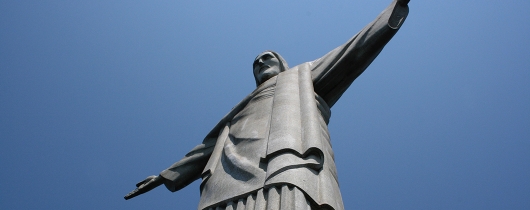Christologies | Cristologías

St. Gregory the Great
Colossians 1:15-20; Luke 5:33-39
Today’s readings present us with contrasting Christologies, or theologies related to the person, nature, and role of Jesus. Our first reading is likely an early hymn with a high Christology. Jesus is “the image of the invisible God, the firstborn of all creatures” in whom “all fullness was pleased to dwell.” Further, “He is before all things,” the one in whom everything is held together, and “the head of the Body, the Church.” In short, Jesus is both beginning and culmination.
Our gospel reading features a decidedly lower Christology. Here, Jesus is the bridegroom whose presence is a cause for celebration, not fasting. He uses readily accessible metaphors—patches and clothing, wine and wineskins—to describe his message and ministry, and why they are resisted by the scribes and Pharisees.
There are many Christologies, but there is only one Christ. Like the pieces of an ancient mosaic, each of them captures something of the whole and shares an essential unity. The Christ exalted in heaven is also the Christ lifted up on the cross. The Son of God is also the son of Joseph and Mary. Through the intercession of St. Gregory the Great, the embodiment of a pastoral bishop, we pray for the grace to receive the new wine he offers us in the gospels and, like fresh wineskins, to be stretched so that we can pour out what we have received in loving witness and service to others. - jc
----------------------------------------------------------------------------------------
San Gregorio Magno
Colosenses 1,15-20; Lucas 5,33-39
Las lecturas de hoy nos presentan cristologías contrastadas, o teologías relacionadas con la persona, la naturaleza y el papel de Jesús. Nuestra primera lectura es probablemente un himno primitivo con una alta cristología. Jesús es "la imagen del Dios invisible, el primogénito de todas las criaturas" en el que "toda la plenitud se complació en habitar". Además, "Él es antes de todas las cosas", aquel en quien todo se mantiene unido, y "la cabeza del Cuerpo, la Iglesia". En resumen, Jesús es a la vez principio y culminación.
Nuestra lectura del evangelio presenta una cristología decididamente inferior. Aquí, Jesús es el novio cuya presencia es motivo de celebración, no de ayuno. Utiliza metáforas fácilmente accesibles -parches y ropa, vino y odres- para describir su mensaje y su ministerio, y el motivo por el que los escribas y fariseos se oponen a ellos.
Hay muchas cristologías, pero sólo hay un Cristo. Como las piezas de un antiguo mosaico, cada una de ellas recoge algo del conjunto y comparte una unidad esencial. El Cristo exaltado en el cielo es también el Cristo levantado en la cruz. El Hijo de Dios es también el hijo de José y María. Por la intercesión de San Gregorio Magno, la encarnación de un obispo pastor, pedimos la gracia de recibir el vino nuevo que nos ofrece en los evangelios y, como odres frescos, ser estirados para poder derramar lo que hemos recibido en el testimonio amoroso y el servicio a los demás. - jc




